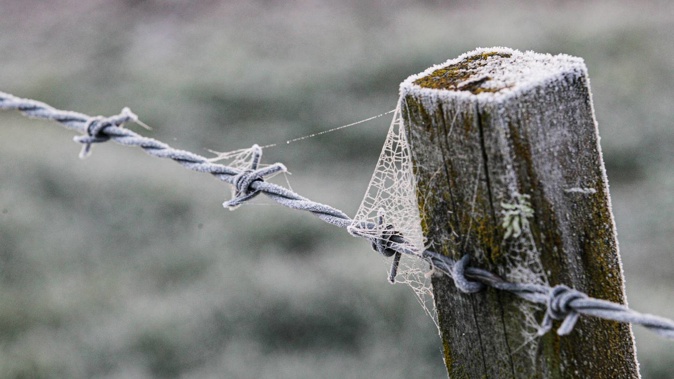
Kiwis can expect to finally feel El Niño’s influence over the next three months, Niwa says, with a weekend polar blast delivering a taste of the big climate driver’s cooler winter flavour.
After what’s been another of our warmest Junes on the books – this month’s temperatures have been tracking around 1C above average – the rest of winter marks a transition that climate scientists have long been anticipating.
That was the shift from La Niña’s remnant warm and wet patterns to those of its climatological counterpart, El Niño, bringing colder south and southwesterly winds across much of the country.
“And right out of the gate in this three-month period, we’re going to feel something that’s more like what we’d expect in an El Niño winter,” Niwa forecaster Ben Noll said.
New Zealand’s first major winter storm of the year was expected to bring cold temperatures and strong winds, courtesy of a mass of freezing Antarctic air blowing up the country over coming days.
MetService reported snow could also fall to 200m around Dunedin, and 300m over Banks Peninsula from Saturday night, and urged travellers to check for local road closures.
“Severe gale winds are possible for the entire North Island, particularly the east coast south of Napier, as well as parts of Nelson and Marlborough and the southern and eastern coasts of the South Island from Saturday until Monday,” MetService meteorologist Alain Baillie said.
“Meanwhile, heavy rain could impact from the Central Plateau south to the Tararua Range and the Buller region of the South Island from Saturday.”
Noll said that, while we’d still be seeing a “tug-of-war” in local weather patterns as the Pacific completed its transition to El Niño - another burst of easterly flows could occur over the second week of July – Niwa’s just-issued outlook from here to September presented a big change to what we’ve grown used to.
/cloudfront-ap-southeast-2.images.arcpublishing.com/nzme/PXS537PTONGFXPM2TFJDS5N5JY.png)
- Weather: Cold, windy start to school holidays after mild early winter
- An ‘unprecedented drought’ is affecting the Panama Canal. El Niño could make it worse
- Horror-show snow queues in Aus forecast difficult winter holiday conditions
Image / Niwa
“The north and west of the North Island and the north and east of the South Island all have an elevated chance for drier-than-normal conditions,” he said, pointing to the potential for more high-pressure systems to build in from Australia.
“This would constitute our driest outlook that we’ve seen in some time for the majority of the country.”
Residents of the saturated and storm-battered East Coast would likely welcome the forecast return to normal rainfall levels, he said, with fewer easterly flows reducing the odds of more plumes of subtropical moisture.
In the west of the South Island – which recently experienced one of its driest, warmest summers – rainfall levels were expected to be above normal or above normal over the next three months.
“Temperature-wise, while the trend is cooler, we’re still looking at average or above average for the whole country for this period,” Noll said.
“We could have several opportunities for cold southerly bursts to come northward, as we’ll see here in early July, but these are being moderated by the fact that we have ongoing marine heatwave conditions near the South Island and the lower North Island.”
Still, after three back-to-back record-warm winters, Noll expected conditions later this season could register differently for Kiwis.
“Even if temperatures end up being near average, people will still feel cold.”
/cloudfront-ap-southeast-2.images.arcpublishing.com/nzme/TLEOJBV5PFHSNFOCRQE6ZVGG3A.png)
Image / Niwa
Looking further ahead, climate scientists were watching for the potential formation of another driver that could have a major bearing on our weather later in 2023.
That was the positive phase of the Indian Ocean Dipole (IOD) - a far-off phenomenon that involved cooler-than-average sea water building up to the northwest of Australia, near Indonesia.
This in turn could turn the tropical moisture tap off to large parts of Australia and even extend as far afield as New Zealand.
Noll pointed out that Auckland’s 2019-2020 drought - the worst in a century - happened to be kickstarted by a strongly positive IOD event, which also coincided with Australia’s catastrophic bushfires.
At this point, though, he said it was far too early to be panicking about drought in some regions.
“It’s more just about being mindful of the outcomes that these climate drivers have led to in the past, and at least starting to think about that for summer.”
Niwa’s latest outlook comes as a new analysis shows the last November-to-March period was the second warmest on record for the wider New Zealand region.
Climate scientist Professor Jim Salinger’s calculations showed that, over New Zealand’s land area and its 4.2 million square kilometres of ocean estate, temperatures averaged more than 1.1C above normal over the latest warm season.
“This was owing to marine heatwave conditions around New Zealand, which produced out-of-range fish stocks, more sponge bleaching in the fjords, and problems for aquaculture.”
Take your Radio, Podcasts and Music with you








